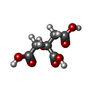+Search query
-Structure paper
| Title | Structure and inhibition mechanism of the human citrate transporter NaCT. |
|---|---|
| Journal, issue, pages | Nature, Vol. 591, Issue 7848, Page 157-161, Year 2021 |
| Publish date | Feb 17, 2021 |
 Authors Authors | David B Sauer / Jinmei Song / Bing Wang / Jacob K Hilton / Nathan K Karpowich / Joseph A Mindell / William J Rice / Da-Neng Wang /  |
| PubMed Abstract | Citrate is best known as an intermediate in the tricarboxylic acid cycle of the cell. In addition to this essential role in energy metabolism, the tricarboxylate anion also acts as both a precursor ...Citrate is best known as an intermediate in the tricarboxylic acid cycle of the cell. In addition to this essential role in energy metabolism, the tricarboxylate anion also acts as both a precursor and a regulator of fatty acid synthesis. Thus, the rate of fatty acid synthesis correlates directly with the cytosolic concentration of citrate. Liver cells import citrate through the sodium-dependent citrate transporter NaCT (encoded by SLC13A5) and, as a consequence, this protein is a potential target for anti-obesity drugs. Here, to understand the structural basis of its inhibition mechanism, we determined cryo-electron microscopy structures of human NaCT in complexes with citrate or a small-molecule inhibitor. These structures reveal how the inhibitor-which binds to the same site as citrate-arrests the transport cycle of NaCT. The NaCT-inhibitor structure also explains why the compound selectively inhibits NaCT over two homologous human dicarboxylate transporters, and suggests ways to further improve the affinity and selectivity. Finally, the NaCT structures provide a framework for understanding how various mutations abolish the transport activity of NaCT in the brain and thereby cause epilepsy associated with mutations in SLC13A5 in newborns (which is known as SLC13A5-epilepsy). |
 External links External links |  Nature / Nature /  PubMed:33597751 / PubMed:33597751 /  PubMed Central PubMed Central |
| Methods | EM (single particle) |
| Resolution | 3.04 - 3.12 Å |
| Structure data | EMDB-22456, PDB-7jsj: EMDB-22457, PDB-7jsk: |
| Chemicals |  ChemComp-NAG:  ChemComp-X3M:  ChemComp-NA:  ChemComp-CIT: |
| Source |
|
 Keywords Keywords | MEMBRANE PROTEIN / Transporter / Inhibitor |
 Movie
Movie Controller
Controller Structure viewers
Structure viewers About Yorodumi Papers
About Yorodumi Papers







 homo sapiens (human)
homo sapiens (human)